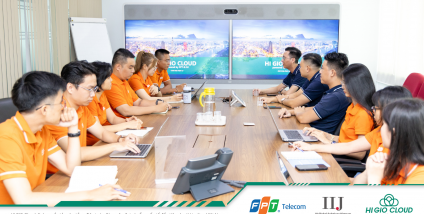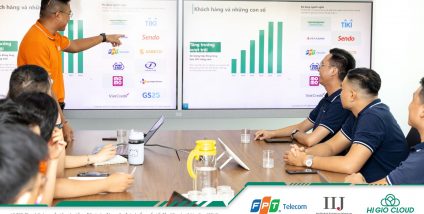Cloud computing is a booming industry in Vietnam, with the highest growth rate in the ASEAN region. According to various international organizations, the average annual growth rate of Vietnam’s cloud market is projected to be 26%. However, a survey by the IBM Institute for Business Value (IBV) shows that only 56% of Vietnamese businesses have adopted cloud management platforms, which means that nearly half of them are still hesitant to migrate from on-premise solutions to the cloud. Therefore, it is important to understand:
- What are the differences between on-premise and cloud solutions?
- What is the best choice for your business?
In this article, we will try to answer these questions and provide some guidance for businesses facing this critical decision.
1.What is On-premise?
On-premise is a technology solution that allows businesses to store data on their own servers and operating systems.
With on-premise solutions, businesses require IT teams to manage the physical hardware, such as installing and maintaining the servers, as well as setting up security policies and systems for the IT infrastructure.
2.What is Cloud?
Cloud Computing, entails the delivery of computing services over the Internet with a pay-as-you-go approach. These resources encompass tools and applications like data storage, servers, databases, networks, and software.
Rather than purchasing, installing, owning, and maintaining on-premises data centers, enterprises can fully leverage the aforementioned services from a third-party Cloud Service Provider (CSP). Through this solution, the service provider assumes responsibility for managing server infrastructure, updating hardware and software, and implementing security solutions to ensure uninterrupted system operation for users.
There are three types of cloud computing service models: Infrastructure as a service (IaaS), Platform as a service (Paas), Software as a service(Saas)
- IaaS: This level provides users with the basic computing resources, such as servers, storage, and networks, that they can configure and manage themselves. Users have more control over the infrastructure, but also more responsibility. For example, with HI GIO Cloud’s portal, users can flexibly upgrade capacities such as CPU, memory, or storage. AWS, Azure, and HI GIO Cloudare prominent examples of this model.
- PaaS: It provides users with a ready-made environment for developing and deploying web applications and software without having to install or maintain any hardware or software. Users can focus on their core business logic and functionality, but have less control over the underlying infrastructure. Heroku is a popular example of this model.
- SaaS: It provides users with a complete software product that they can access and use via the internet. Users do not have to worry about the installation, maintenance, or update of the software, but they have limited customization options. Microsoft Office 365 is a well-known example of this model.
3.On-Premises vs. Cloud Computing Comparison
Each solution has its own advantages and disadvantages, and the choice of cloud or on-premise application depends on the goals and needs of each business. Let’s compare the main differences between on-premise and cloud computing below:
1- Control ability
On-premise: It allows businesses to have full access, control, and management of their data systems. Moreover, on-site storage can be accessed even without an internet connection. This is an advantage for businesses that have high security needs. However, this solution also requires a highly qualified IT team to upgrade, operate, and manage the system.
Cloud: It helps businesses save human resources. The service provider’s team of experts will be responsible for the system. Users can easily manage, monitor, and configure the system through the provider’s Service Management Portal (Portal).
2- Confidentiality
On-premise: Hardware and software are installed on the business’s premises and solely operate within the internal network, so data is completely stored in accordance with the business’s security policies and regulations.
Cloud: Business data undergoes encryption and is stored in a data center system that meets international standards, such as ANSI/TIA-942, Uptime Tier, ISO 9001, ISO 27001, ISO 27017, ISO 50001, and PCI DSS to ensure compliance and security. Cloud solutions also have less risk of hardware or software failures, thanks to the provider’s backup plans to prevent attacks, disasters and secure data.
With HI GIO Cloud service, the infrastructure is well-equipped from hardware to software:
- FPT’s nationwide data center system meets international standards, such as ANSI/TIA-942, Uptime Tier III Facility, ISO 9001, ISO 27001, and ISO 27017.
- The infrastructure is protected by a powerful firewall system, such as L4 Firewall and WAF (Web Application Firewall), which can prevent various types of cyberattacks.
3 – Implementation efficiency
On-premise: All resources are installed and deployed directly into the enterprise infrastructure. Enterprises can have full authority to license internal accounts, as well as directly manage the infrastructure without being affected by any third party. Businesses can also upgrade or customize their on-premise infrastructure according to their needs. However, updating and upgrading the system can take 3-6 months and requires experienced staff and the ability to handle arising problems.
Cloud: All business data stored on the cloud platform. The service provider will be fully responsible for the system and services, from storage, security and to upgrade stored. With HI GIO Cloud infrastructure, it also helps businesses monitor, stabilize, synchronize, and secure servers, ensuring to minimize downtime when any disaster occurs through the Data Center-Disaster Recovery model that meets international standards.
Besides, businesses also receive other outstanding benefits such as:
- Easy Management & Operation: Enterprises can easily manage, monitor, and configure resources through the service provider’s management portal. With HI GIO Cloud infrastructure, the portal interface is optimally designed, enhancing the user experience with features such as tracking resources used on each VM, supporting TOTP MFA and SMS MFA. In addition, HI GIO Cloud’s experts also provide customer support 24/7/365 free of charge.
- High flexibility: Businesses can easily scale up or down resources quickly at any time with direct operations on the portal. With HI GIO Cloud infrastructure, enterprises can also use the Auto Scale feature, which helps balance resources between VMs to ensure your work is not interrupted and takes place at a faster speed.
- Access anytime, anywhere: Businesses can enable their employees to work anywhere with an internet connection, including 4G and 5G connections. The cloud also allows users to work on any device including a PC, laptop, tablet or mobile phone. With HI GIO Cloud infrastructure, you can benefit from FPT Telecom’s powerful backbone system of up to 80 Gbps, internal connection speed of up to 100 Gbps, which meets your high access needs.

- Upgrading & Updating Quickly
Service providers continuously upgrade and update new technology from software to hardware to provide effective solutions in both application and cost. With HI GIO Cloud Gen 2 infrastructure, some of the typical solutions applied are:
- NVME hard drive platform (much faster than SSD) that helps increase performance and has low latency, to ensure it meets customer requirements when running Big Data, AI, etc.
- Network system that applies Spine-Leaf Network Architecture (a new trend for network design standards) to create a fast, predictable, scalable and efficient communication architecture in data center environments.
- Increased channel availability when using both MPLS and VPN.
- Cost
On-premise: Businesses have to pay costs such as:
- Capital costs (CAPEX – Capital Expenditure) to build a data center system, such as purchasing server equipment, networks, firewalls, etc.
- Monthly system maintenance fees, such as electricity, maintenance fees, etc.
- Fees for hiring and training IT personnel to build and operate the system.
Cloud: Helps organisations avoid investing in server hardware, network equipment, and a management team, but only pay for the resources used monthly (OPEX – Operating Expenditure) through the Pay-as-you-go (PAYG) method. Businesses do not have to spend budget on building, maintaining the system or staffing, as the service provider will be fully responsible for these costs.
4. Conclusion
Although businesses in the Vietnamese market are increasingly moving from on-premise to cloud computing due to its flexible scalability, cost efficiency, easy management, outstanding performance, and comprehensive security, the decision to choose between cloud computing and on-premise solutions also depends on the business’s goals, strategy, and application capabilities.



